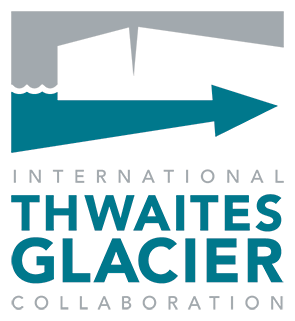“We found a sea pig last night in one of the Megacore tubes,” Jennie Mowatt, a marine technician onboard, nonchalantly said as she passed around a video on her cell phone for all of the scientists in the meeting. With my late-night schedule, I had literally just thrown myself down from my top rack (bunk on the ship), gotten dressed and walked a couple rooms down to join our daily 0830 science planning meeting, eyes barely starting to open and adjust to the light. I had recently seen the hilarious YouTube video “True Facts about the Sea Pig” on the ship, so when Jennie casually made the comment, I immediately came out of my fogginess, excited. The 3 or 4 inch-long, piggish, many-legged cousin of the sea cucumber moving on the screen was gelatinous, tinted lightly pink, and transparent enough to see its organs. The sea pig had been in the core tube for about 24 hours when he had been discovered rooting around in the mud, or what geologists would refer to as bioturbating, which isn’t ideal for getting a good sediment core record. Our sea pig needed to come out.
The “Megacorer” that caught this fascinating creature was a 12-barrel coring contraption. A steel frame rings a square with four clear tubes on each side of the corer with a metallic web of complex trigger mechanisms at the top. On a perfect grab, it can capture 12 tubes of the interface between the ocean and sediment, with about 20 inches (50 cm) of it being sediment. Captured in 4-inch (10 cm) diameter transparent tubes, each core looked like a mud aquarium that might display worms, anemones, and other rare animals, like the sea pig. Linking back to my previous blog and the idea that one person’s noise is another’s signal, these creatures would have been interesting to study if we had a biologist onboard, but the sea pig wasn’t what we were there for. The THOR group was coring sediment for the story they could tell us about the history of Thwaites Glacier.
The crane lowered the little orange submarine until it finally touched down snuggly onto its ramp on the back deck of the Palmer. Behind it, the overcast, foggy skies blended into the glacier front a few kilometers away and down to the rest of the ocean surrounding us. As soon as the Hugin rested in its aluminum cradle, Anna Wåhlin, eyes bright and a devious smile beaming across her face, gave a giant high five to Aleksandra Mazur. The Hugin Autonomous Underwater Vehicle (AUV) had just returned from its ninth deployment that, on the surface, appeared to be an uneventful one with calm waters and a simple recovery. Knowing Anna, though, that smile and high five meant something more than your average Hugin homecoming.
“I think the secret to the work we do in many ways is as much as possible beforehand, asking the question, ‘what if, what if, what if.…’” Andy Smith, a principal investigator on the ITGC GHOST project, commented about working in Antarctica’s isolated and difficult outback. “You have to get used to the fact that you can have a wonderful plan on paper, and it’ll change completely when you’re actually trying to achieve it.” Looking back on our cruise, this mantra has unquestionably held true. When you work in Antarctica, you work in one of the harshest environments in the world, and definitely the most remote. That means contending with a wide range of unpredictable weather and ice conditions, medical challenges with the nearest hospital four days away, and instruments and infrastructure that take a beating or become obstinate in freezing wet conditions. The fact that we now sat with Andy at the British Antarctic Survey’s Rothera Station on the Antarctic Peninsula was testament to that.
While the seal team sat on one of the smaller Shaeffer Islands tagging their second and third seals (described in a previous blog post), GHC scientists, Scott Braddock and Meghan Spoth from the University of Maine, dug through ancient beaches for the Geological History Constraints (GHC) project of the International Thwaites Glacier Collaboration (ITGC). Scrambling off of the small boat onto the shore, I could see these relict beaches clearly along the gradual slope of the island. Lines of beach sediments stepped upward, looking to the eye like rounded and slightly lumpy terraces. They used to be the shoreline of this island, but now sit meters above the water line.
Calling it seal tagging doesn’t really put the right image in your mind. I had pictured a seal with a small plastic tag attached to its body like you’d see on a cow or pig ear. Seeing it in person was a surprise. Imagine a 600 lb (300 kg) Weddell seal with big dark eyes, a small radio glued to the top of its head, and a black antenna poking up like a single antler. Instead of a gorgeous unicorn, though, you have a huge slug-shaped animal that has no care in the world right now other than to sleep in the sun and eat every once in a while. Four bright orange foreigners who tug on her fur are no match for her relentless mission to out-couch-potato every other creature on Earth.
As we travel among the Thwaites menagerie of giant icebergs, it’s hard to believe that a thousand feet below the ship sits warm water. This ocean layer, moving slowly toward the base of the ice deep beneath the floating ice shelves has led to faster ice flow, thinning, and more frequent giant calving events at some of the Antarctic outlet glaciers. The water, called Circumpolar Deep Water (or CDW for short), is “relatively warm,” about 3°C (5°F) above seawater freezing temperatures, and it lies below about 250 m (~900 ft) depth in the oceans surrounding Antarctica. The water has a huge melting potential for the ice shelves and icebergs that it interacts with, including the Thwaites Glacier, our main target, but the question is how much of it actually reaches the ice.
You may have heard about the B-46 iceberg that broke off in October last year from Pine Island Glacier (adjacent to Thwaites), measuring about 40 km (25 miles) across, about four times the size of Manhattan. In the last two decades, there have been large calving events like this one in 2001, 2007, 2013, 2015, 2017, and now 2018. In most places, calving occurs regularly, with some ice breaking off and then ice behind it filling its place. The past few years of rapid calving at Pine Island has led to a retreat of Pine Island Glacier. Thwaites Glacier has also seen an increase in calving and break-up of ice at its “grounding line,” the region where the flowing ice begins to float on seawater. That line has moved steadily landward for both these massive glaciers, and for the entire coastline of Pine Island Bay.
The TARSAN research team on this cruise is primarily focused on understanding this layer of warm water, how much heat it carries to the big glaciers, and how it ultimately impacts the ice. By February 8, two days after we saw the first iceberg, we had just begun the work planned to study the water column and, especially, the Circumpolar Deep Water there. We had conducted two CTD casts, one in the deep Southern Ocean and one here on the continental shelf. CTD stands for conductivity (used to calculate salinity), temperature, and depth. The CTD instrument is a giant cylinder of silver metal bars with a ring of long gray bottles for water sampling. A cluster of instruments sits at the base of the cylinder. It’s the oceanographer’s bread-and-butter for studying water masses throughout the world. Dropping the CTD down to the ocean floor gave us a detailed picture of the cool, slightly fresher water near the surface and the warm, salty water sitting below it for that specific time and location.
“Iceberg! Starboard beam.” I was sitting at my computer typing and I think it took a second to sink in for me and everyone else in the room. Then we were all on our feet in a flurry, rushing to each of our personal stashes of camera equipment scattered throughout the ship, and up to the bridge on the 05 deck, five levels up a monotonous steel staircase from the main deck. I opened the door and, as I stepped outside, I saw the bright white island towering a half kilometer from the ship, off the "starboard beam," which is a nautical term for right side of the ship in the 3 o’clock direction. Then I heard everyone’s exclamations. “Whoa!” “So beautiful.” “I would never have imagined.” Clicking filled the air as all of the scientists’ cameras worked hard to capture every angle of that first sighting. The scale of the berg was beyond what first-timers to Antarctica had expected, but it paled in comparison to what we would soon encounter. We were still two full days away from Antarctica and the edge of the Amundsen Sea.
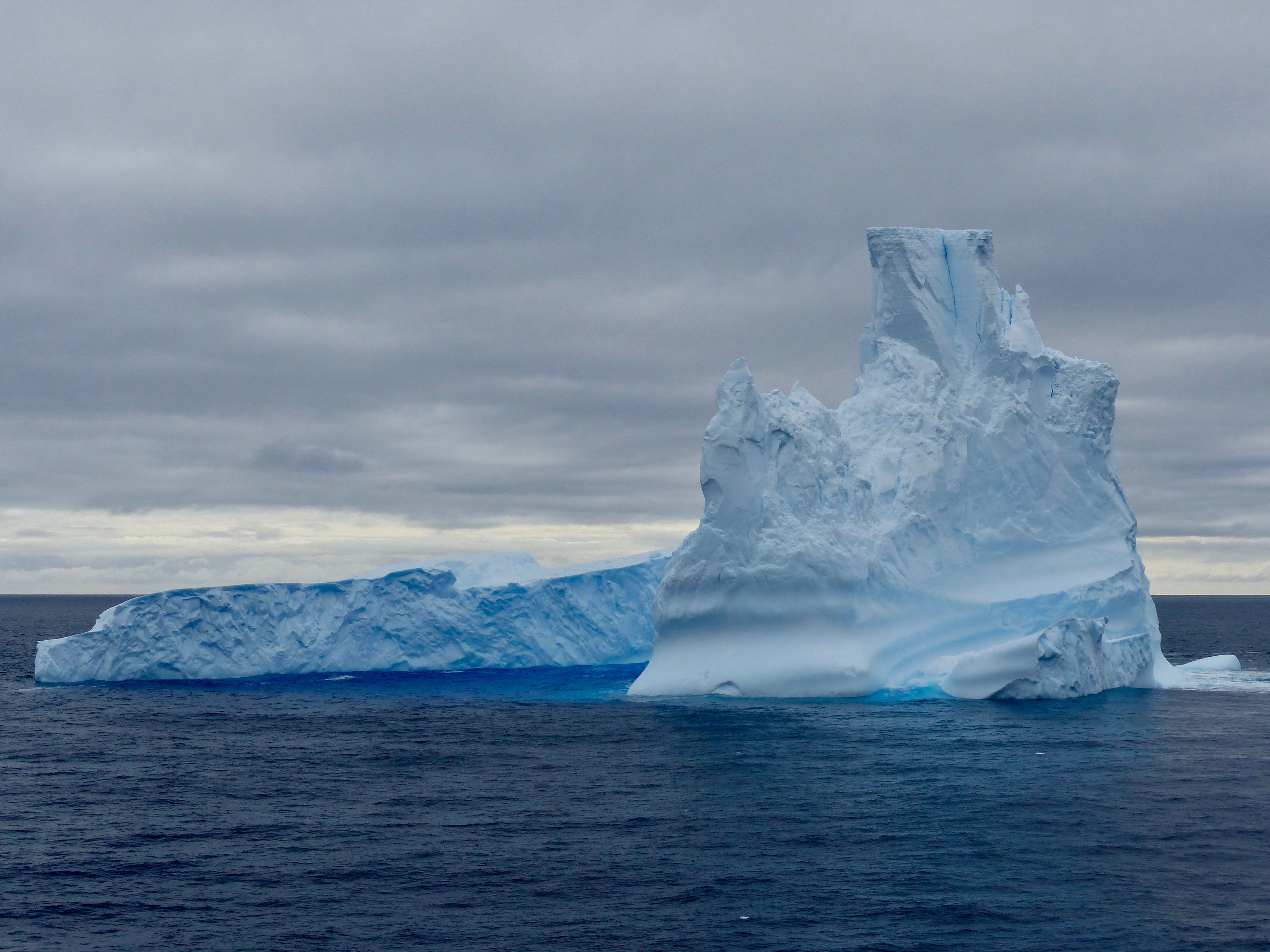
That first iceberg didn’t give the impression it was drifting. Measuring larger than a football field across, its immensity made it seem like the ship was the only one in motion. As the day progressed, though, more began to appear and you started to get the sense of a migration away from Antarctica. The closer to the source the more there were. It’s a journey many set out on from Antarctica; only a few make it as far north as that iceberg did before they melt and break apart.
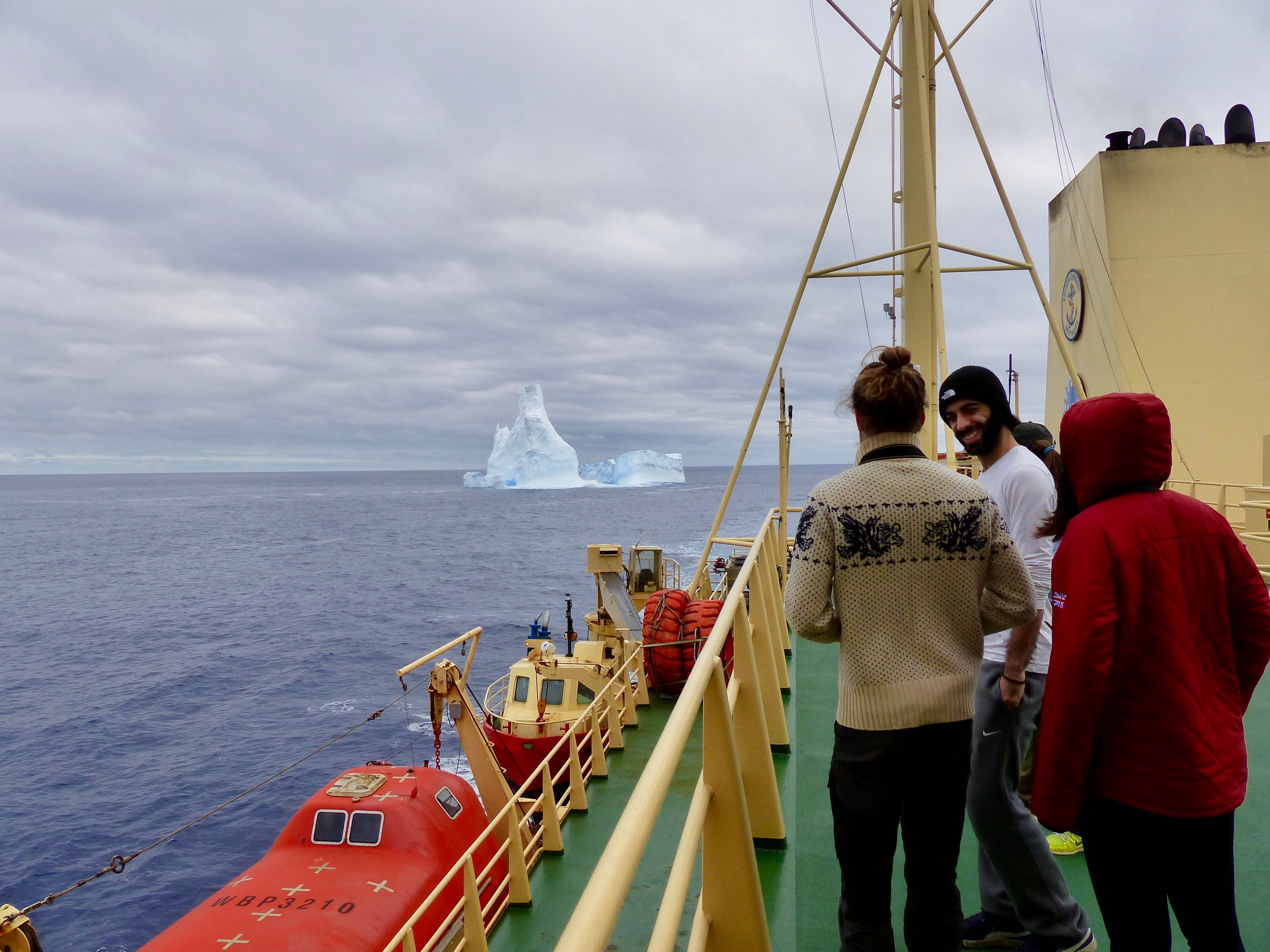
Icebergs here have come from the glaciers and ice shelves around Antarctica. Ice shelves are floating extensions of the ice sheet and glaciers that flow out onto the ocean and serve as added stability for the ice sheet behind it. Icebergs constantly break off (called calving) from the ice shelves around Antarctica, many of them the size of the first iceberg we saw, others, the size of your local downtown area. Many researchers, including a few within the ITGC, study icebergs to learn more about how the ice sheet is changing and will change in the future. Some icebergs, traveling from Antarctica to the north into warmer water, can be used as a natural experiment for examining how an ice shelf might respond to a much warmer environment. The shape and size of icebergs can tell us something about the processes that may have caused the calving and about the condition of the ice it broke off from. Onboard, Aleksandra Mazur, a postdoctoral researcher from the University of Gothenburg in Sweden, has studied how to track icebergs from space to determine how long they stay in the Amundsen Sea and how the numbers have changed over time. The ones out here in the Southern Ocean have been floating for anywhere from a few months to more than ten years and many have been sculpted by the ocean in uniquely spectacular ways. Each one is a masterpiece and the ones we have seen in the past two days since our first sighting have been no different.
The ship bobbed lazily in the Straits of Magellan, ringed by the snow-capped mountains of the far southern Andes, the sun becoming quite warm, the water still as glass. You can imagine what song was stuck in my head as we stood on the 01 Deck looking out at the stern of the ship where the HUGIN Autonomous Underwater Vehicle (AUV) sat waiting to be deployed. It is an orange, not yellow, torpedo-shaped submarine, and unlike the one from the famous Beatles song, it is definitely uninhabitable. Instead, it will hopefully be used to venture on its own under the Thwaites and Pine Island ice shelves to map the cavity underneath and measure the water properties underneath that are both vital to predicting “How much, how fast” ice will be lost from Thwaites and its adjacent areas. Before that, though, its skills must be tested.
Today, February 1, was to be its first test deployment by the N. B. Palmer crew and technicians and of course everyone was nervous to see how it would go. The HUGIN, built by Kongsberg for the University of Gothenburg, was the first to be made for scientific research. All of its predecessors have gone to industry and the military. The AUV, named “Ran” after the Norse goddess of the sea, was purchased by Anna Wåhlin’s team from Sweden through the Knut and Alice Wallenberg Foundation. The private Swedish foundation makes expensive projects, like this one, possible for scientists in the small country.
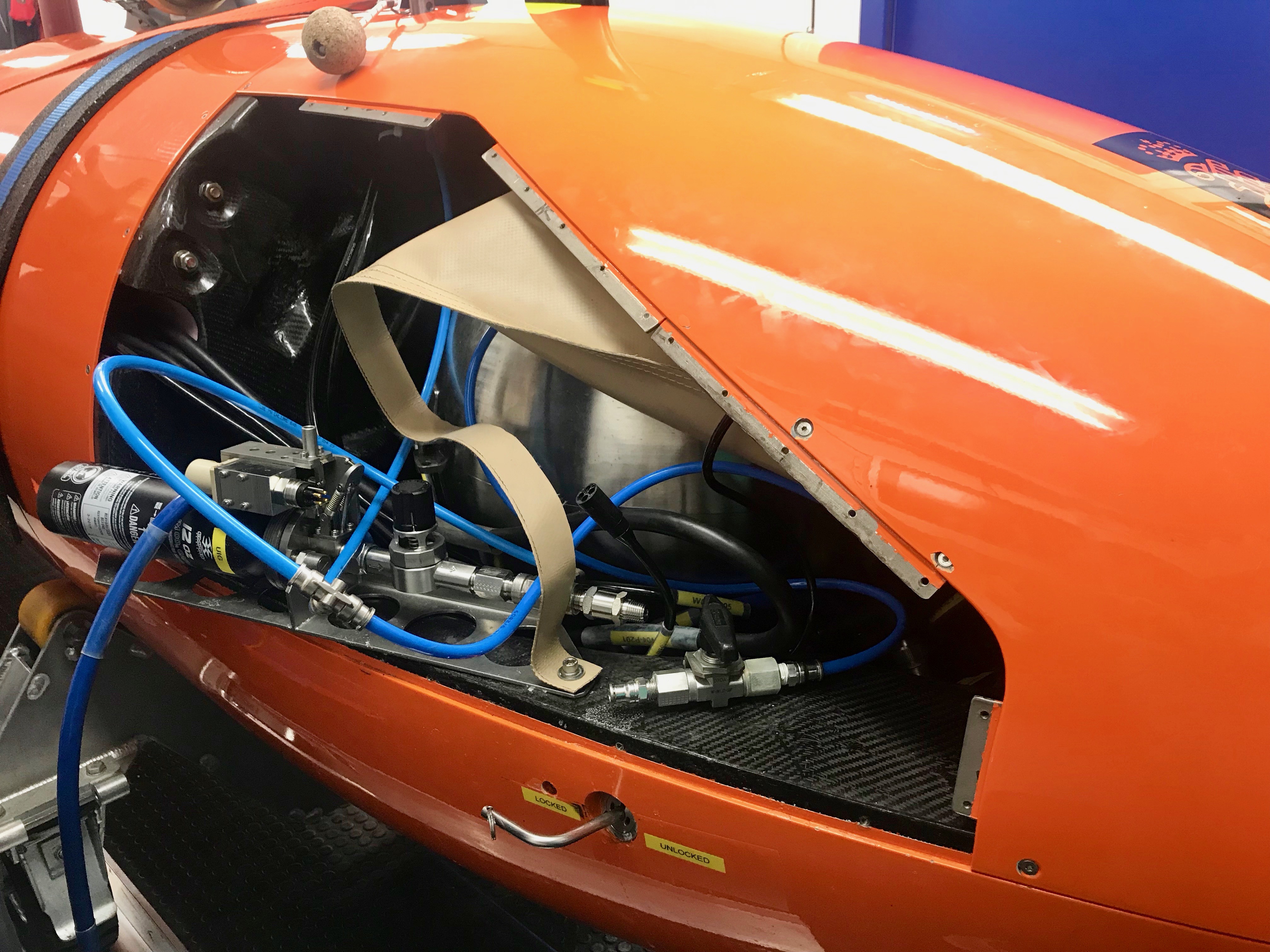
With 20 instruments onboard for navigation, measuring water properties (e.g. temperature and salinity), taking water samples, and mapping, the HUGIN used by Wåhlin’s team will be able to capture a 3D picture of what is transpiring beneath the surface around the Amundsen Sea. Ran will be able to run missions for up to 24 hours, completely on its own. It will venture to depths up to 1.5 km (1 mile) at the front of the Thwaites and elsewhere within the Amundsen Sea, though is rated to go twice that depth. The navigation system, sitting in a sterile-looking silver sphere in the nose of the sub, uses a combination of sonar, dead reckoning, and inertial navigation to track its path underwater and keep it from bumping into any unforeseen obstacles ahead, above, or below. This AUV was designed for harsh, unchartered, and frequently changing environments: floating sea ice at the surface, deep-drafted icebergs, or a completely unknown cavity under the ice shelf. After it finishes its multi-year ITGC project, the HUGIN will eventually be available to other scientists, both from Sweden and other nations around the world, through a proposal process. This research purchase will achieve the greater good for many years to come.
Standing with a vantage point from above, scientists and crew gathered on deck to watch the marine technicians get the little orange submarine off the deck. A Zodiac (small boat) with two marine techs glided protectively near the stern. Using the stern A-frame and ropes to guide its harness, the AUV was lowered into the water, detached, and there she went. We had a bit of a "NASA moment," at that point. Maybe not the same kind of cheering you expect when a rocket safely leaves the launch pad, but a few claps, relief, and gleaming smiles to match the weather. We watched as the HUGIN continued to sit at the surface while it slowly filled with water for its dive. About 10 minutes later, the orange torpedo with its black snorkel-looking antenna faded beneath the surface. Graduate student Rachel Clark’s cheeky sentiment, she recalled later, spoke for many of us I think, “Well, hopefully it comes back.”
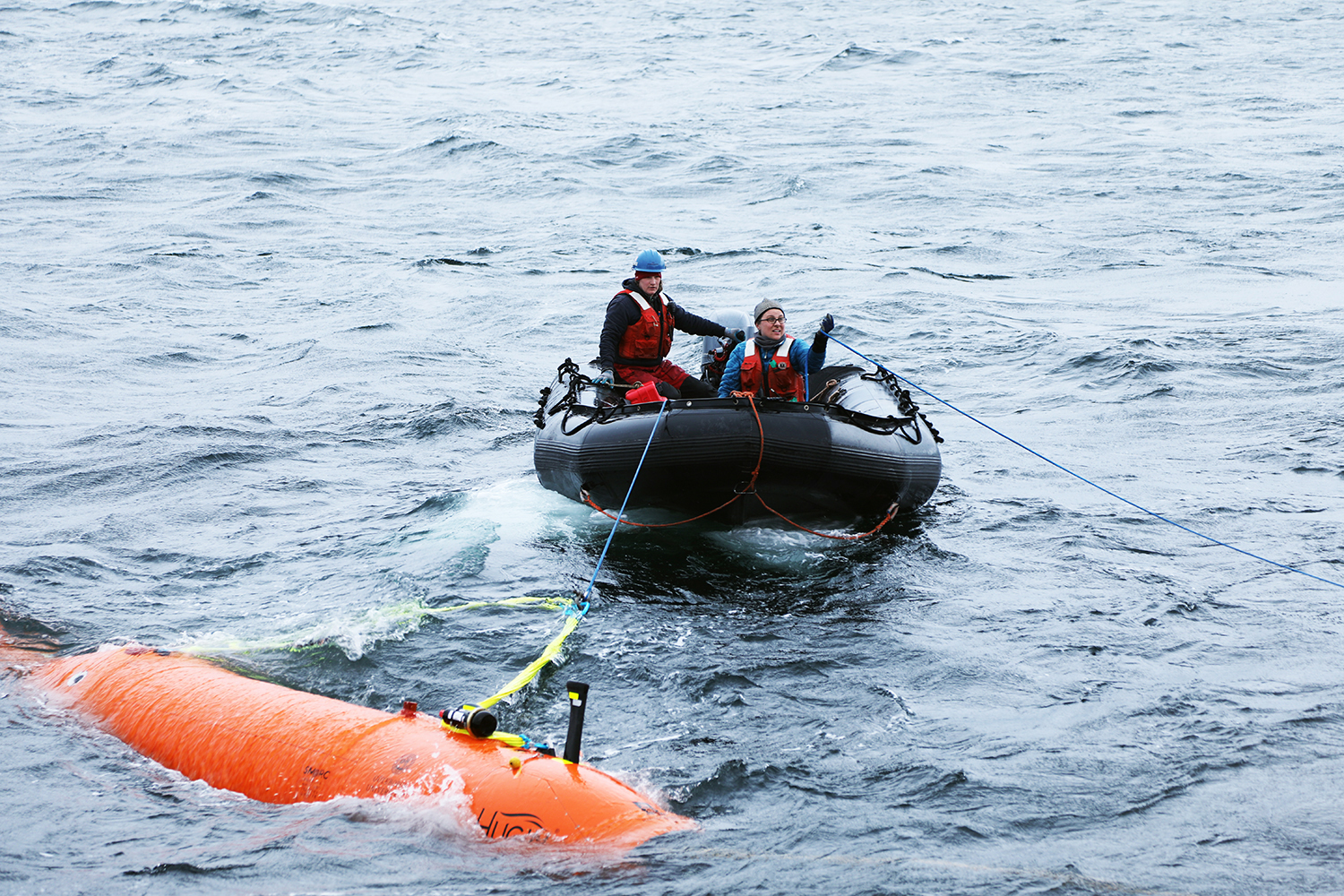
During this test, the AUV was to dive down to specific depths within the Straits of Magellan, navigate to several designated points, and then return to the ship four hours later. The ship, in the meantime, loitered nearby with a transducer in the water to listen and give basic commands if needed. Traveling back to the designated rendezvous point on the ship, we all gathered again to look for the AUV. Then it was sighted. The little orange submarine bobbed to the surface exactly as expected.
Ran checked out with all of the sensors for today. The successful test gets the HUGIN one step closer to the AUV test-of-all-tests: the almost completely unknown underside of the Thwaites ice shelf.
We arrived into Punta Arenas on January 26th and met our US Antarctic Program (USAP) representative, Maribel. During our short time in Punta Arenas, we received our polar gear for the trip, participated in mandatory training sessions, and boarded the N. B. Palmer the next evening. We were underway soon thereafter, a day earlier than expected, to go to the refueling pier on the other side of town. After the hustle and bustle of getting the last non-ship bite eat, grabbing a few bags of dry fruit and loose ends from the store, and hustling to email a few large data files before we have restricted internet bandwidth on the ship, we all made it onboard.
We enjoyed the most spectacular “leaving port” experience I think I have ever had. It was a beautiful day, but it was the whales that blew our minds. You learn as a marine mammal observer that the spouts are their give-away. Clouds of spray rise into the air, varying in size and shape depending on the breed, and you can see them at quite a distance. Apparently, there was a gathering of at least 50 whales occurring in the bay as we were leaving. A handful of 2-3m (7-15 ft) tall spouts at various distances could be seen in any direction you looked in a moment. Excited debate among our TARSAN seal team members and resident marine mammal experts, Lars Boehme and Guilherme Bortolotto (a.k.a. Gui) from the University of St Andrews in St Andrews, Scotland, deduced that they were Sei whales. Their cousins, the Minke, are a species common both here and in Antarctica where we are headed. Minke whales are small - about the size of an Orca - with a little crescent moon-looking dorsal fin that cuts out of the water when they surface. These looked the same, just with a body 11 m (~40 ft) longer instead. A native Brazilian researcher who studied humpbacks for his graduate work, Gui pointed out how much he would like to come study these giants the next time he ventures down to Punta Arenas. Some whale species give birth in entirely different parts of the world than they feed. Where and why they tend to congregate is often poorly understood and Gui is the type of person who would love to find that out. They certainly put on a show, today, that any whale researcher would salivate over.
A few hours later, the N. B. Palmer made it pier-side on the other side of Punta Arenas to refuel. We got through refueling and in the process of running through pre-checks before our next underway, the rudder did not pass its check. Having spent some time in the Navy, these sorts of hang-ups are familiar. Mechanical issues are usually common on ships. Waves constantly beat up machinery. Saltwater is hard on parts. Kelp, algae, and barnacles like to make a home on the hull or tangle around parts (called bio-fouling). It’s par for the course on a ship. To be honest, though, this is my second cruise on the Palmer and I have been surprised by how rarely mechanical issues come up on this ship. This is easily the smoothest-running ship I have seen, despite its 25 years of age and the extreme weather and environments it is constantly subject to. It makes sense since the Palmer runs a level of work that requires no margin for error. Science time in the Antarctic is precious beyond measure, expensive, and there is no one out there to save you if you break down, so the crew has to be better than anyone else at keeping the ship purring like a kitten. Passengers are fortunate on this ship: 40ft seas with 60ft rogue waves, or ice thicker than I am tall, piece of cake. For the rudder, all we needed was an extra day in port, a couple visits by divers, and the ship was ready to go.
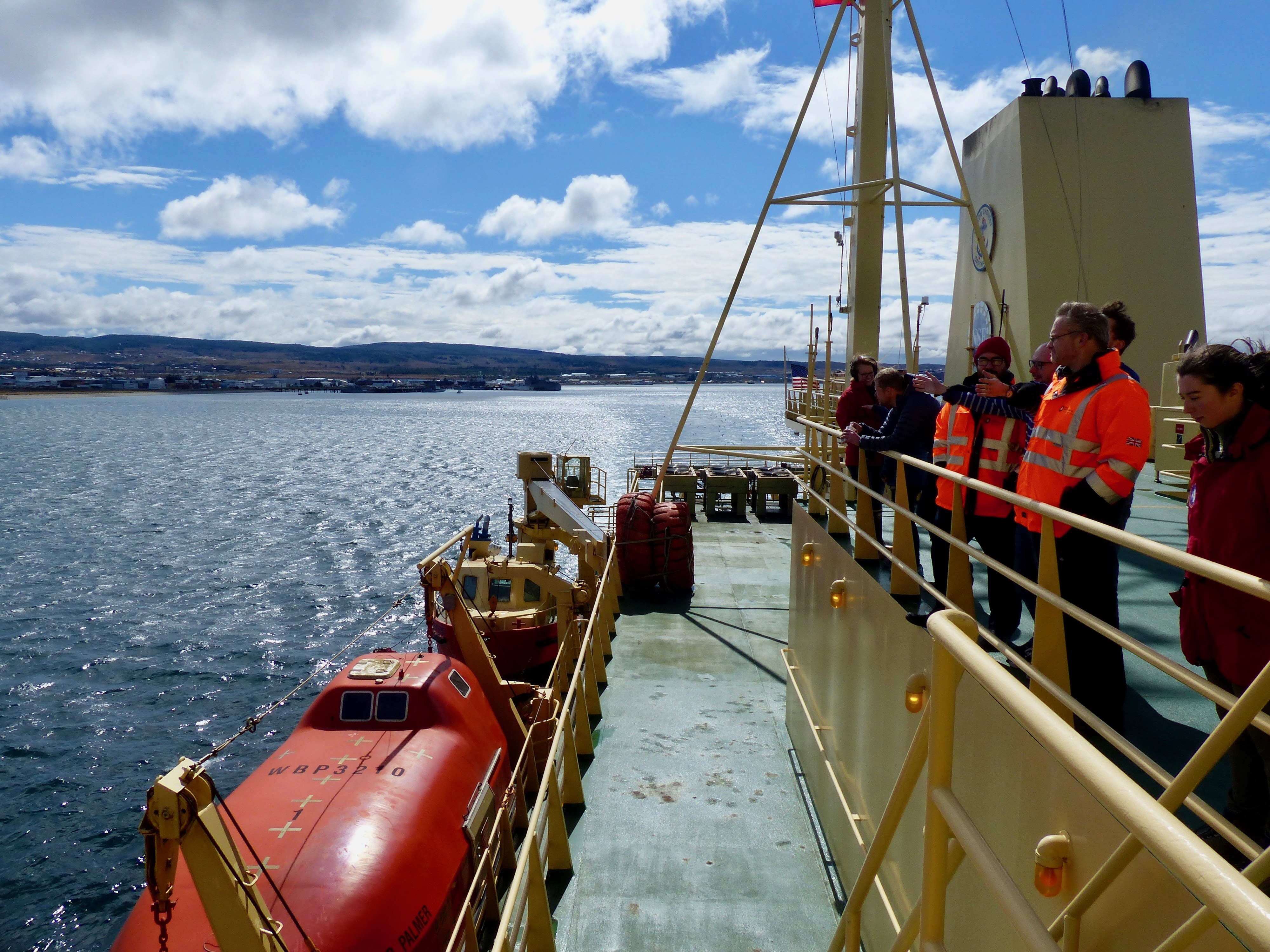
On January 28th, we watched as Punta Arenas fell away behind us, not to return until March 22nd. First, we were headed for the Straits of Magellan and a testing of the Hugin Autonomous Underwater Vehicle, then the legendary Drake Passage in the Southern Ocean, and beyond that, the ice. Only a few whales and playful pods of Peale’s dolphins on this departure, but the energy was sky-rocketing. Scientists and crew alike were literally bouncing up and down or grinning from ear to ear, the veterans even more so. Those of us who have been here before, sailor and scientist alike, know what waits for us in the ice and can’t get there soon enough. There is an enormous amount of ground-breaking science that will be done soon.
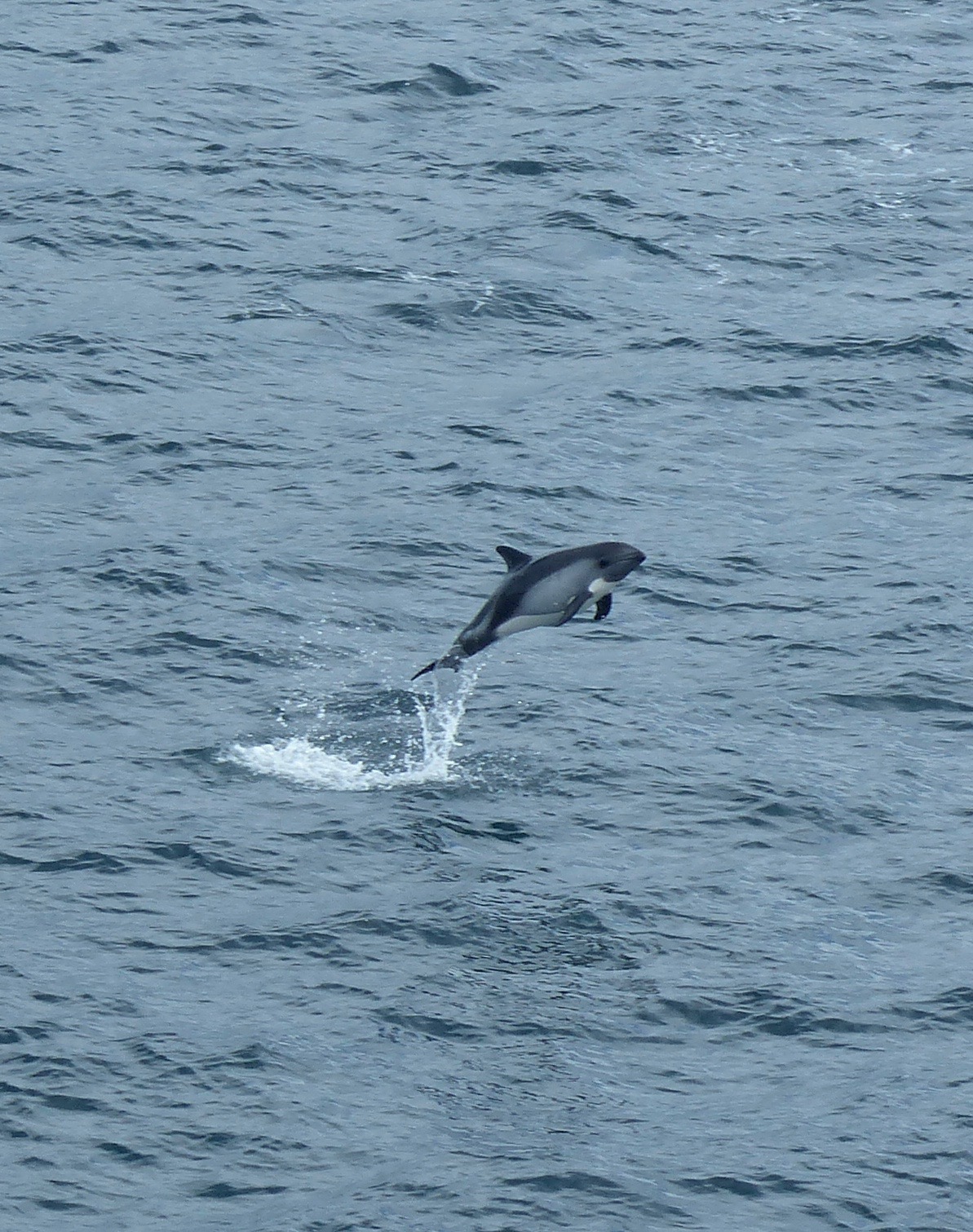
Flying out of Denver, CO, USA on January 26th to start the first leg of my journey south to Antarctica, I admired the beautiful mountain landscape covered in half a foot of fresh white powder that had fallen the day before. Fifteen hours later, I debarked into the Santiago, Chile, cradled between the mostly snowless peaks of the Andes. With my winter clothing on, stepping off the plane into the record breaking 40°C summer day sent me scrambling to take off some layers. It almost slipped my mind; there is a second half of the planet and it never sees a white Christmas. After a long layover in the swarming airport and another 4-hour jog, we descended into Punta Arenas, Chile, I found myself looking onto a windy landscape, covered by pockets of water and, bordered by the glistening Straits of Magellan. Punta Arenas is the gateway to the famous Torres del Paine and the launching point for research cruises headed to the Antarctic Peninsula and West Antarctica. For the moment, it served as the temporary berth for the RVIB (research vessel ice breaker) Nathaniel B. Palmer, the new home to 25 scientists and myself for the next two months on a journey to conduct research at the Thwaites Glacier. Before I go further, let me introduce myself.
My name is Tasha Snow and I am a PhD student and glaciologist (glacier scientist) at the University of Colorado Boulder. Like many people in Boulder, I am a fanatic for everything outdoors: honestly, you name it. My two addictions are tasty food and problem solving anything, and you can often find me in my free time cuddling on the couch or tossing a frisbee with my Golden Retriever, Lily. Unlike most people, my love and work is of water and ice. I use satellite imagery to study how glaciers and oceans interact and have changed over time. Maybe my last name sealed my fate for me, but I would be more likely to point to my first glimpse of Antarctica that did it. It’s impossible not to fall in love. I think if you continue following the cruise, you will understand why.
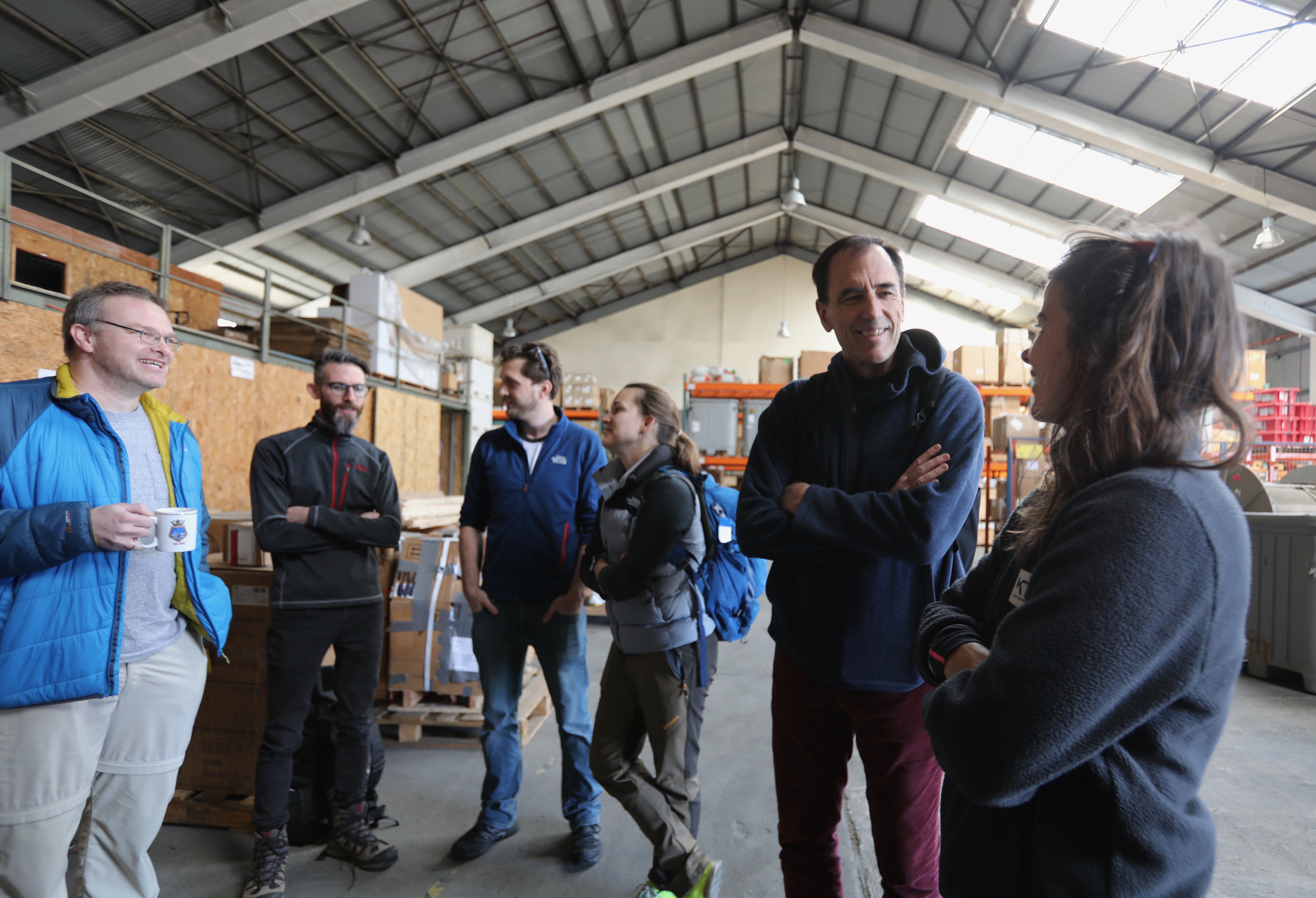
While I am a scientist, my work on the Palmer takes a different form. For the next two months, I will be the resident media facilitator, working as a liaison for the three media personnel onboard and the scientists. I will be helping to ensure they are able to capture and provide to you, the stories of the crucial International Thwaites Glacier Collaboration (ITGC) research. You will also get a glimpse into the personal journeys of the researchers and ship’s crew that make it all possible. Carolyn Beeler is the environment reporter for The World, a daily, nationally-distributed public radio show based in Boston, and for Boston Calling, its sister program that airs on the BBC World Service. Jeff Goodell is a contributing editor for Rolling Stone Magazine and a book writer. National Science Foundation has also funded a creative non-fiction author, Elizabeth Rush Mueller, to join through the NSF Antarctic Artists and Writers Program. A fellow scientist, Linda Welzenbach, will be serving as the outreach and documenting specialist for the THOR group. They will all be putting out periodic reports and blogs from the ship that will be linked to this site. The media will also have longer edited pieces and books that make it out to you once we return home. Make sure to keep an eye out for them as well.
We have an incredible group headed down to conduct science and help document all of the discoveries we make at Thwaites. Researchers from THOR will be collecting ocean sediments to tackle questions of past changes at Thwaites spanning back thousands of years. The TARSAN group has its sights set on exploring the ocean properties near Thwaites with a range of cutting edge technologies, including the Hugin autonomous underwater vehicle and instruments tagged to seals – Austin Powers will be put to shame. Alongside the other groups, GHC scientists will seek out rock debris, penguin bones, and molted seal hair at ancient exposed beaches that will help will help determine the area's glacial retreat and expansion history. The vibrant scope of research planned for this cruise will make every day an uncharted adventure.
Now, in the gateway town to the Antarctic, we have our stepping off point for the rest of the journey, soon to be made over the waters of the Drake Passage. Stay tuned.
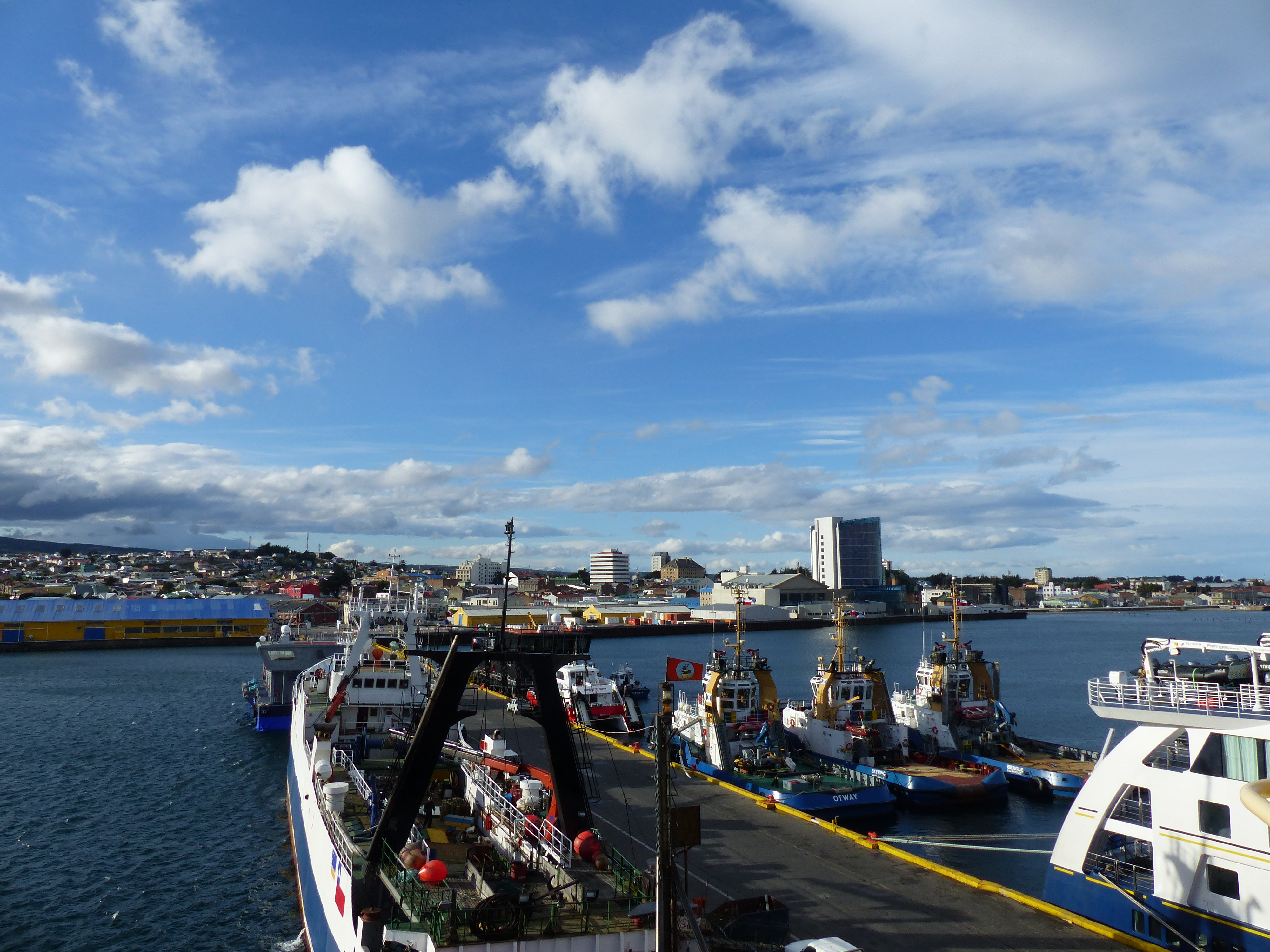
A view of Punta Arenas, Chile, from the bridge wing of the RVIB N. B. Palmer. Photo credit: Tasha Snow
